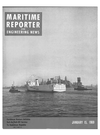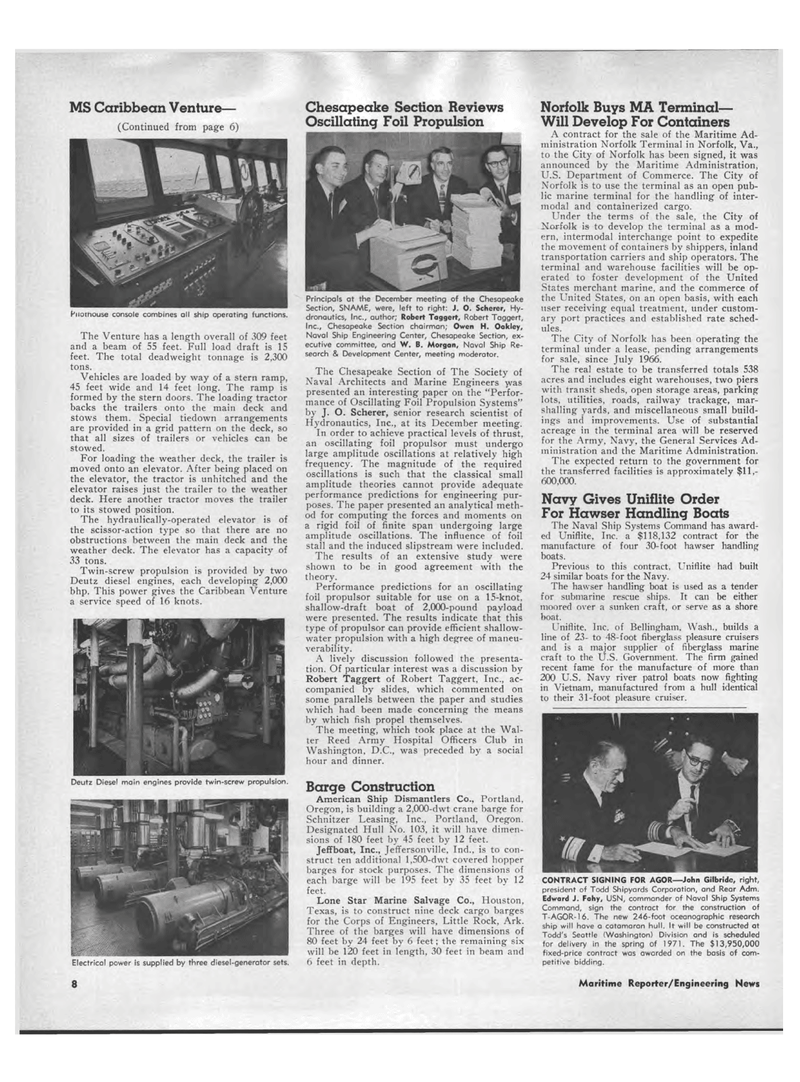
Page 6: of Maritime Reporter Magazine (January 15, 1969)
Read this page in Pdf, Flash or Html5 edition of January 15, 1969 Maritime Reporter Magazine
MS Caribbean Venture? (Continued from page 6) Pilothouse console combines all ship operating functions. The Venture has a length overall of 309 feet and a beam of 55 feet. Full load draft is 15 feet. The total deadweight tonnage is 2,300 tons. Vehicles are loaded by way of a stern ramp, 45 feet wide and 14 feet long. The ramp is formed by the stern doors. The loading tractor backs the trailers onto the main deck and stows them. Special tiedown arrangements are provided in a grid pattern on the deck, so that all sizes of trailers or vehicles can be stowed. For loading the weather deck, the trailer is moved onto an elevator. After being placed on the elevator, the tractor is unhitched and the elevator raises just the trailer to the weather deck. Here another tractor moves the trailer to its stowed position. The hydraulically-operated elevator is of the scissor-action type so that there are no obstructions between the main deck and the weather deck. The elevator has a capacity of 33 tons. Twin-screw propulsion is provided by two Deutz diesel engines, each developing 2,000 bhp. This power gives the Caribbean Venture a service speed of 16 knots. Electrical power is supplied by three diesel-generator sets. 8 Chesapeake Section Reviews Oscillating Foil Propulsion Principals at the December meeting of the Chesapeake Section, SNAME, were, left to right: J. O. Scherer, Hy-dronautics, Inc., author; Robert Taggert, Robert Taggert, Inc., Chesapeake Section chairman; Owen H. Oakley, Naval Ship Engineering Center, Chesapeake Section, ex-ecutive committee, and W. B. Morgan, Naval Ship Re-search & Development Center, meeting moderator. The Chesapeake Section of The Society of Naval Architects and Marine Engineers was presented an interesting paper on the "Perfor-mance of Oscillating Foil Propulsion Systems" by J. O. Scherer, senior research scientist of Hydronautics, Inc., at its December meeting. In order to achieve practical levels of thrust, an oscillating foil propulsor must undergo large amplitude oscillations at relatively high frequency. The magnitude of the required oscillations is such that the classical small amplitude theories cannot provide adequate performance predictions for engineering pur-poses. The paper presented an analytical meth-od for computing the forces and moments on a rigid foil of finite span undergoing large amplitude oscillations. The influence of foil stall and the induced slipstream were included. The results of an extensive study were shown to be in good agreement with the theory. Performance predictions for an oscillating foil propulsor suitable for use on a 15-knot, shallow-draft boat of 2,000-pound payload were presented. The results indicate that this type of propulsor can provide efficient shallow-water propulsion with a high degree of maneu-verability. A lively discussion followed the presenta-tion. Of particular interest was a discussion by Robert Taggert of Robert Taggert, Inc., ac-companied by slides, which commented on some parallels between the paper and studies which had been made concerning the means by which fish propel themselves. The meeting, which took place at the Wal-ter Reed Army Hospital Officers Club in Washington, D.C., was preceded by a social hour and dinner. Barge Construction American Ship Dismantlers Co., Portland, Oregon, is building a 2,000-dwt crane barge for Schnitzer Leasing, Inc., Portland, Oregon. Designated Hull No. 103, it will have dimen-sions of 180 feet by 45 feet by 12 feet. Jeffboat, Inc., Jeffersonville, Ind., is to con-struct ten additional 1,500-dwt covered hopper barges for stock purposes. The dimensions of each barge will be 195 feet by 35 feet by 12 feet. Lone Star Marine Salvage Co., Houston, Texas, is to construct nine deck cargo barges for the Corps of Engineers, Little Rock, Ark. Three of the barges will have dimensions of 80 feet by 24 feet by 6 feet; the remaining six will be 120 feet in length, 30 feet in beam and 6 feet in depth. Norfolk Buys MA Terminal? Will Develop For Containers A contract for the sale of the Maritime Ad-ministration Norfolk Terminal in Norfolk, Va., to the City of Norfolk has been signed, it was announced by the Maritime Administration, U.S. Department of Commerce. The City of Norfolk is to use the terminal as an open pub-lic marine terminal for the handling of inter-modal and containerized cargo. Under the terms of the sale, the City of Norfolk is to develop the terminal as a mod-ern, intermodal interchange point to expedite the movement of containers by shippers, inland transportation carriers and ship operators. The terminal and warehouse facilities will be op-erated to foster development of the United States merchant marine, and the commerce of the United States, on an open basis, with each user receiving equal treatment, under custom-ary port practices and established rate sched-ules. The City of Norfolk has been operating the terminal under a lease, pending arrangements for sale, since July 1966. The real estate to be transferred totals 538 acres and includes eight warehouses, two piers with transit sheds, open storage areas, parking lots, utilities, roads, railway trackage, mar-shalling yards, and miscellaneous small build-ings and improvements. Use of substantial acreage in the terminal area will be reserved for the Army, Navy, the General Services Ad-ministration and the Maritime Administration. The expected return to the government for the transferred facilities is approximately $11,-600,000. Navy Gives Uniflite Order For Hawser Handling Boats The Naval Ship Systems Command has award-ed Uniflite, Inc. a $118,132 contract for the manufacture of four 30-foot hawser handling boats. Previous to this contract, Uniflite had built 24 similar boats for the Navy. The hawser handling boat is used as a tender for submarine rescue ships. It can be either moored over a sunken craft, or serve as a shore boat. Uniflite. Inc. of Bellingham, Wash., builds a line of 23- to 48-foot fiberglass pleasure cruisers and is a major supplier of fiberglass marine craft to the U.S. Government. The firm gained recent fame for the manufacture of more than 200 U.S. Navy river patrol boats now fighting in Vietnam, manufactured from a hull identical to their 31-foot pleasure cruiser. CONTRACT SIGNING FOR AGOR?John Gilbridc, right, president of Todd Shipyards Corporation, and Rear Adm. Edward J. Fahy, USN, commander of Naval Ship Systems Command, sign the contract for the construction of T-AGOR-16. The new 246-foot oceanographic research ship will have a catamaran hull. It will be constructed at Todd's Seattle (Washington) Division and is scheduled for delivery in the spring of 1971. The $13,950,000 fixed-price contract was awarded on the basis of com-petitive bidding. 8 Maritime Reporter/Engineering News Deutz Diesel main engines provide twin-screw propulsion.

 5
5

 7
7
